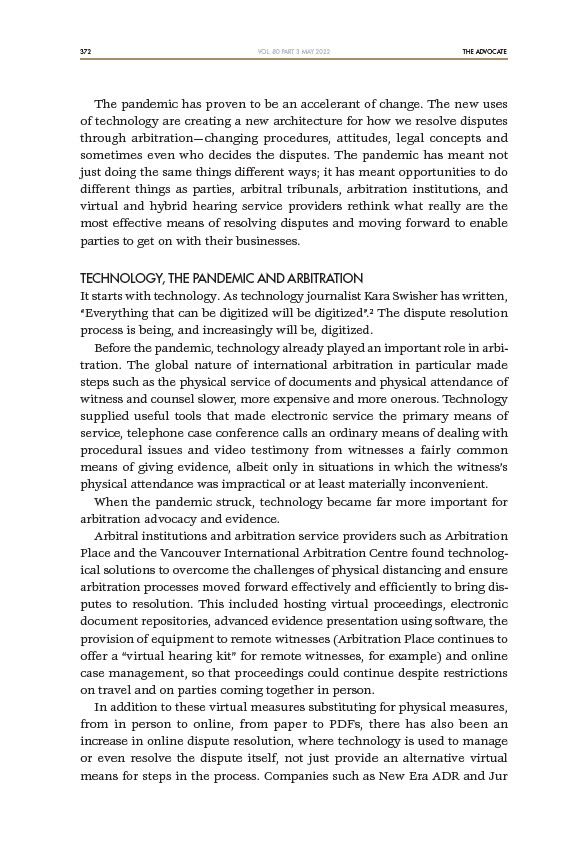
372 THE ADVOCATE
VOL. 80 PART 3 MAY 2022
The pandemic has proven to be an accelerant of change. The new uses
of technology are creating a new architecture for how we resolve disputes
through arbitration—changing procedures, attitudes, legal concepts and
sometimes even who decides the disputes. The pandemic has meant not
just doing the same things different ways; it has meant opportunities to do
different things as parties, arbitral tribunals, arbitration institutions, and
virtual and hybrid hearing service providers rethink what really are the
most effective means of resolving disputes and moving forward to enable
parties to get on with their businesses.
TECHNOLOGY, THE PANDEMIC AND ARBITRATION
It starts with technology. As technology journalist Kara Swisher has written,
“Everything that can be digitized will be digitized”.2 The dispute resolution
process is being, and increasingly will be, digitized.
Before the pandemic, technology already played an important role in arbitration.
The global nature of international arbitration in particular made
steps such as the physical service of documents and physical attendance of
witness and counsel slower, more expensive and more onerous. Technology
supplied useful tools that made electronic service the primary means of
service, telephone case conference calls an ordinary means of dealing with
procedural issues and video testimony from witnesses a fairly common
means of giving evidence, albeit only in situations in which the witness’s
physical attendance was impractical or at least materially inconvenient.
When the pandemic struck, technology became far more important for
arbitration advocacy and evidence.
Arbitral institutions and arbitration service providers such as Arbitration
Place and the Vancouver International Arbitration Centre found technological
solutions to overcome the challenges of physical distancing and ensure
arbitration processes moved forward effectively and efficiently to bring disputes
to resolution. This included hosting virtual proceedings, electronic
document repositories, advanced evidence presentation using software, the
provision of equipment to remote witnesses (Arbitration Place continues to
offer a “virtual hearing kit” for remote witnesses, for example) and online
case management, so that proceedings could continue despite restrictions
on travel and on parties coming together in person.
In addition to these virtual measures substituting for physical measures,
from in person to online, from paper to PDFs, there has also been an
increase in online dispute resolution, where technology is used to manage
or even resolve the dispute itself, not just provide an alternative virtual
means for steps in the process. Companies such as New Era ADR and Jur